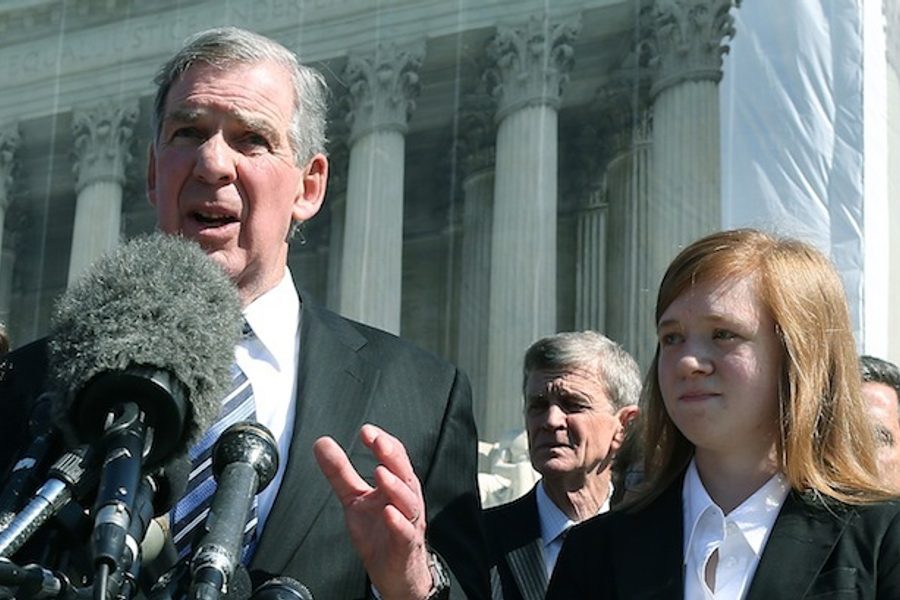
Once again, affirmative action is on trial in the Supreme Court. The pending case, Fisher v. University of Texas at Austin, challenges U.T. Austin’s admissions policy, which aims to bring in more students of color by considering race among other factors. The case is driven by the misplaced racial anxieties provoked by affirmative action, but it might offer a platform for truly grappling with the nature of institutional racism and the oft-politicized, seldom-understood concept of “equal opportunity” in schools and workplaces.
The backlash against affirmative action—and more broadly against institutional efforts to desegregate schools and workplaces—has been accompanied by straw-man accusations of “reverse racism,” heard in debates about everything from President Obama to high school textbooks. Meanwhile, affirmative action’s detractors paper over the persistent inequities across our workplaces and classrooms.
A new book, Documenting Desegregation, sheds light on how racial inequity really works and why it’s so pernicious. The book traces the evolution of equal opportunity policies under the Civil Rights Act since its implementation in the mid-1960s. The authors, sociologists Kevin Stainback and Donald Tomaskovic-Devey, tell Working In These Times that effective enforcement of civil rights depends on both strong pro-integration policies and, more importantly, grassroots political movements that can hold institutions accountable.
At the height of the civil rights movement, activists and progressive politicians crafted affirmative-action policies aimed at fostering desegregation, particularly in government-sponsored enterprises. At first, they worked. Using data from the Equal Employment Opportunity Commission, Stainback and Tomaskovic-Devey explain in an email to Working In These Times:
Our analysis of more five million private sector workplaces since the Civil Rights Act of 1964 reveals that Affirmative Action appears to have been successful at increas[ing] employment and even some coveted managerial jobs for African American[s] in the 1960s and into the 1970s.
However, that progress halted in the Reagan Era. Affirmative action, the authors say, “appears to have provided some benefits for racial minorities and women prior to 1980, and stalled in the 1980s. Many indicators of equal opportunity for blacks and women indicate some worsen[ing] since the 1990s.”
So how did the movement to institutionalize racial and gender equity peter out within a generation? The neoliberal reaction of the 1980s generated fierce pushback against the radical mass movements that had exploded in the previous two decades. In workplaces and government, the concept of equal opportunity as social justice was corroded, while “human resource” management “shifted away from race-based affirmative action to a focus on race-neutral celebrations of diversity.”
The authors argue that white-male dominance in the workforce is rooted in the interplay between the political environment and the lack of institutional systems of redress for endemic inequality: “Changes in law may be necessary, but they are simply not sufficient to motivate change in organizational behavior.” So formal policies are in many cases necessary, but need to be backed by a progressive political culture. Likewise, attributing institutionalized discrimination to a few racist or sexist individuals in the administration misses the point: Organizational culture can reinforce and validate prejudice, or help dismantle it. The authors write, “Even if racial or gender bias is declining or becoming rare, group-level decision-making makes the probability of some type of individual prejudice or bias being present in the group skyrocket. Thus, the prevention of bias is not about changing social psychology but about changing organizational behavior and practice.” Sustainable civil-rights gains require focused policies to remedy discrimination at the workplace level, as well as government regulation when public resources or funding is at stake.
The authors’ research shows that racial and gender divisions typically track economic barriers, suggesting the limitations of “diversity” advancements in individual workplaces:
High-wage industries are the most likely to show patterns of resegregation after the waning of the political pressure generated by the civil rights and women’s movements. Women and minority progress into equal-status contact with white men and into the most desirable jobs is now most likely to occur in low-paying workplaces.
In higher economic tiers, segregation is most acute. Research shows that in the 20 industries where “white men’s advantaged access to managerial jobs is the most extreme… white men were found in managerial roles at two to three times their representation in the local labor market more generally.”
Some industries actually seem to be regressing. Out of 58 industries surveyed in the book, about a third “showed a trend toward racial resegregation among white men and black men in this century.”
Stainback and Tomaskovic-Devey also explore the role of Asian and Latino immigration in reshaping the racial landscape of the workforce. Contrary to stereotypes, immigration itself doesn’t have a decisive positive or negative economic impact with respect to racial disparities in the workforce. Rather than the oversimplified narrative of one group “taking jobs” from another, it seems that as more workers of color filter into the bottom, other groups tend to get “bumped up” to higher positions, or at least reshuffled, while overall inequality persists:
We do know that contemporary immigrants, like white women, black men, and black women before them, tend to push white men up in the labor queue. That is growth in all of these groups tends to increase white men’s access to skilled blue collar jobs, as well as managerial and professional jobs.
So immigration’s influence on job opportunity reflects biases built into our economic system. As the inevitable influx of economic migrants continues, the “queue” for shrinking opportunities lengthens. As the authors note, this means that “Ironically, the white men with the most advantages produced by immigration and integration are also the ones most likely to work in and perhaps feel threatened by integrated workplaces.”
Meanwhile, the Supreme Court is weighing whether affirmative action in education is as vital today as it was back in the 1960s (in a case brought, ironically, by a young white woman who might consider herself a beneficiary of gender-based affirmative action in previous generations). The question before the court is bigger than Texas’s college admissions; it’s whether society is ready to admit that segregation can’t be “corrected” by token measures like corporate PR “diversity” initiatives.
Inequity is supremely adaptable because the power of capital always requires the exploitation of an underclass. The movement to overturn old hierarchies won’t come down from a federal decree or a company memo, but from a revival of a collective political consciousness. Institutional cultures tend to change in the direction that social movements push them. Half a century ago, people organized and agitated around the demand for real “equal opportunity,” before it was diluted into just another political catch-phrase. Today, organizing communities, students, workers and unions to transform the system remains our best hope for reclaiming that promise.
Michelle Chen is a contributing writer at In These Times and The Nation, a contributing editor at Dissent and a co-producer of the “Belabored” podcast. She studies history at the CUNY Graduate Center. She tweets at @meeshellchen.








